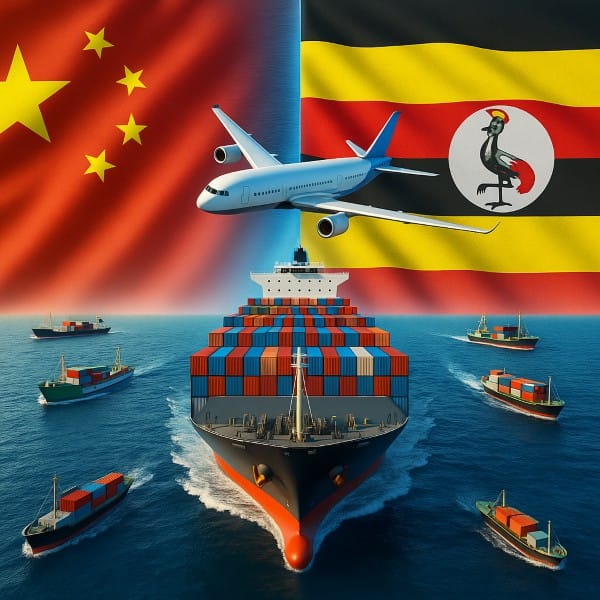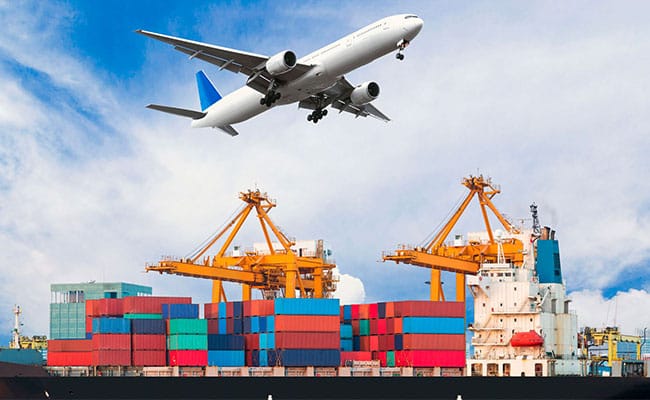As the economic ties between China and Uganda continue to strengthen, the demand for freight exports from China to Uganda continues to grow. Whether it is a corporate customer or an individual buyer, understanding the full process and precautions of China-Uganda freight is of great help to the logistics and transportation between the two countries. This article will introduce the trade situation between China and Uganda in detail.

Uganda import from China
Uganda is a member of the East African Community (EAC) with huge market potential. In addition, its geographical location is superior, and it can radiate to neighboring countries such as Rwanda, South Sudan, and the Democratic Republic of the Congo. It is one of the logistics hubs in East Africa. Uganda’s imports from China have increased year by year, mainly importing:
- Building materials: such as tiles, cement, steel, hardware tools, etc., which are suitable for Uganda’s booming infrastructure construction.
- Mechanical equipment: agricultural machinery, motors, generators, diesel engines, etc. are very popular in the local market.
- Electronic products: mobile phones, televisions, electrical appliances, etc. are in short supply in the Ugandan market.
- Daily consumer goods and household items: such as kitchen utensils, furniture, plastic products, clothing, shoes and hats.
Shipping Methods From China to Uganda
Depending on the nature of the goods, timeliness requirements and budget, the shipping methods from China to Uganda can be divided into the following categories:
Sea Freight
Sea transportation is usually the most economical and efficient mode of transportation, suitable for transporting non-perishable items and heavy goods, reliable and mature routes, suitable for importers with customs clearance capabilities. Supports LCL and FCL:
- FCL: suitable for bulk goods, low cost.
- LCL: suitable for small and medium-sized batches of goods, charged by volume or weight.
Since Uganda is a landlocked country with no seaports, sea transportation needs to pass through ports in neighboring East African countries (such as Mombasa Port in Kenya or Dar es Salaam Port in Tanzania), and then transfer the goods to Uganda by land transportation.
Air Freight
Air freight is the most efficient option for transporting goods from China to Uganda. It has a fast transportation time, generally only 3-7 days; it is highly secure and suitable for fragile, high-value, small-volume goods (such as electronic products, accessories, etc.), with a fast customs clearance process and high reliability, benefiting from predictable schedules and fewer delays. Cargo restrictions, not suitable for sensitive goods such as batteries, liquids, powders (special customs declaration required)
Shipping Time from China to Uganda
When choosing a mode of transport, understanding the factors that affect the overall time efficiency can help you make more reasonable logistics arrangements:
- Customs clearance speed and Uganda’s local customs clearance process: Special goods or incomplete information may be delayed
- Selected destination or transit country: The distance between the destination, departure and transit port is different, and the resulting time efficiency is also different
- Is it a peak season or holiday: The Spring Festival, National Day, and Christmas are the peak export periods, ports and shipping schedules are tight, and transportation companies and customs clearance delays are more.
Different modes of transportation produce different transportation routes:
- Ocean route: China (Shanghai/Ningbo/Shenzhen) → Mombasa Port, Kenya → Truck transfer to Kampala, Uganda
- Air route: China’s major airports → Entebbe Airport, Uganda
| Shipping method | Estimated Shipping time (working days) | Remarks |
| Sea Freight (full container load) | 30–40 days | Customs clearance and transit take longer |
| Sea Freight (Less than container load) | 40–50 days | Customs clearance and transit take longer |
| Air Freight | 5–10 days | Flight + customs clearance time |
The following are the shipping times from China to surrounding countries:
How Long Does it Take to Ship from China to Kenya?
How Long Does it Take to Ship from China to Tanzania?
Shipping Cost from China to Uganda
Transportation costs vary depending on the volume, weight, mode of transportation, departure and destination of the goods. Mainly affected by the following factors:
- Position of departure port and destination: The longer the inland transit distance, the higher the cost.
- Difficulty of customs clearance and whether to pay taxes: Uganda’s import tariffs and value-added tax will significantly affect the total cost.
- Off-season factors: Freight and warehouse space are tight during the peak season (such as September-December each year), and costs rise.
- Cargo attributes: Dangerous goods and oversized items require additional packaging and supervision fees.
- Additional services: Insurance (0.6% of the value of the goods), customs clearance fees, storage fees, etc. need to be calculated additionally.
Here are the approximate costs for shipping from China to Uganda:
| Shipping Mode | Cost Range | Remarks |
|---|---|---|
| Sea Freight (LCL) | $150 – $190 per cubic meter | Cost-effective for smaller shipments |
| Sea Freight (FCL, 20-foot container) | $2000 – $3500 | Best for large, bulk shipments |
| Sea Freight (FCL, 40-foot container) | $4,500–5,500 | For even larger shipments |
| Air Freight | $7.5 – $10 per kg | Balance between speed and cost |
Read below for shipping costs to other countries to help you understand more:
How Much Does it Cost to Ship from China to Tanzania
How Much Does it Cost to Ship from China to Kenya?

Suggestions for Improving Shipping Efficiency and Safety
Using the following tips can help companies and individuals transport from China to Uganda:
- Prepare documents in advance to avoid delays due to incomplete information;
- Avoid shipping during peak seasons, such as completing shipments before October to save costs;
- Use wooden boxes or pressure-resistant packaging to improve the risk resistance of goods;
- Purchase freight insurance to avoid the risk of cargo damage during transportation;
- Track logistics status and choose logistics channels that provide track inquiries;
- Specify freight forwarders familiar with African business, such as those who can provide transit, double clearance, and door-to-door services.
Uganda’s Import Customs Clearance Process
Uganda customs clearance is mainly completed at the Kampala Inland Customs Clearance Center or border customs clearance station (such as Malaba). The following links need to be paid attention to, and the necessary documents are:
- Commercial invoice
- Packing list
- Bill of lading (sea)/airway bill (air)
- Certificate of origin (CO)
- Pre-shipment inspection certificate (if applicable)
- Importer tax number (TIN) and import license (if any)
Notes
- Ensure the HS code is correct to avoid high taxes caused by incorrect classification.
- Uganda implements an electronic customs clearance system (ASYCUDA), and importers need to register in the system.
- Pay special attention to the tax rate for high-value goods or taxable goods (the common VAT is 18%, and the tariff is about 0-25%).
How to Choose A Reliable Freight Forwarder?
It is very important to choose a professional freight forwarder who is familiar with the China-Africa route. You can refer to the following standards:
- Experience in China-Africa transportation: especially familiar with Uganda’s inland transportation and customs clearance procedures;
- Provide DDU/DDP services: pay customs duties and deliver goods to customers’ homes, suitable for customers who are not familiar with customs clearance;
- Response speed and communication skills: language barrier-free, with a professional customer service team;
- Local cooperation network in Africa: such as fleets, warehouses, agents, etc.;
- Transparent cost quotations: including all links, no hidden costs.
Transporting goods from China to Uganda involves multiple links such as international transportation, port transit, inland transshipment and customs clearance at the destination. Mastering relevant knowledge through this article, choosing the right mode of transportation, and cooperating with professional logistics partners are important prerequisites for ensuring smooth and efficient transportation and reducing costs.
